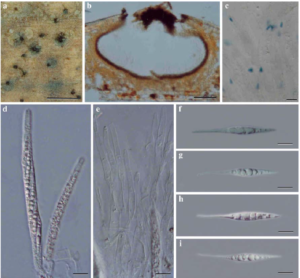Oxydothis atypica Pinruan., in Liu et al., Fungal Diversity: 10.1007/s13225-015-0324-y, [13] (2015)
Index Fungorum Number: IF551015, Facesoffungi number: FoF00485
Etymology – atypica refers to the differences from the typical ascospore characters.
Holotypus – Pinruan 135 in BBH.
Saprobic on dead leaves of Licuala longicalycata Furtado in peat swamp. Sexual morph: Ascomata 270–275μm, visible on the host surface as a minute blackened dot with eccentric, periphysate ostiole, immersed, lenticular to subglobose, brown, coriaceous, scattered. Peridium 10–12.5μm wide, comprising 3–6 layers of flattened, brown-walled cells of textura angularis, fusing at the outside with the host tissues. Paraphyses 8.75μm wide at the base, hypha-like, tapering to the apex, longer than asci, not embedded in a gelatinous matrix. Asci 87.5–95×7.5– 8.75μm, 8-spored, cylindrical, unitunicate, thin-walled, pedicellate, apically rounded, with a J+, cylindrical, subapical ring, 5–5.25μm high × 2.2–2.5μm diam. Ascospores 42.5–45×5– 6.5μm, overlapping 2-seriate, hyaline, 1-septate, tapering gradually to a point at the apex with a mucilaginous drop and with a long drawn-out spine at the base.
Material examined – Thailand, Narathiwat Province, Sirindhorn Peat Swamp Forest, on dead leaves of Licuala longicalycata (Arecaceae), 13 February 2002, U. Pinruan (Pinruan 135 in BBH, holotype).
Notes – The characteristic features of Oxydothis atypica are immersed ascomata with an eccentric neck, well-developed paraphyses, cylindrical asci with a J+, subapical ring and pointed ascospores (Hyde 1995; Hyde and Alias 2000). This species differs from all species of Oxydothis as it has asymmetrical ascospores, with a short pointed apex and a long spine at the base (Hyde 1995; Fröhlich et al. 2000).

Fig. 1 Oxydothis atypica (holotype). a Colonies on substratum. b Section of ascoma. c Asci with J+ ring. d Asci. e Paraphyses. f–i Ascospores. Scale bars a=1000 μm; b=100 μm; c-i=10 μm
